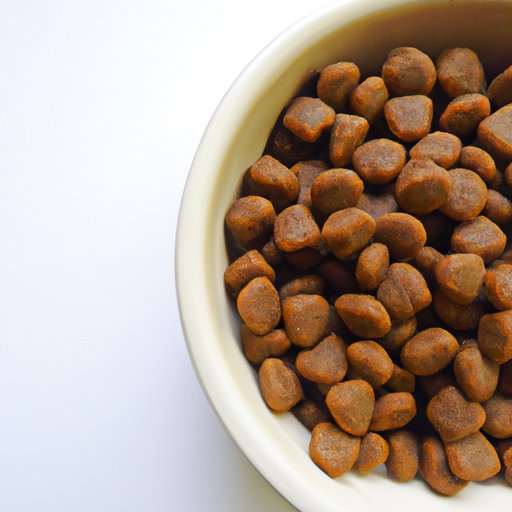
Introduction
Dog food comes in many varieties, with the most common being grain-free. However, pet owners often wonder whether grain-free dog food is good for their furry friend. This article aims to answer that question by discussing the pros and cons of grain-free dog food, debunking myths about the diet, explaining how to choose the right food, examining the nutritional differences between grain-free and traditional dog food, exploring grain allergies, and more.
The Pros and Cons of Grain-Free Dog Food: What You Need to Know
There are several benefits to feeding your dog grain-free food:
- Higher meat content: Grain-free dog food typically has a higher meat content than traditional food, which can be beneficial for dogs that require higher levels of protein.
- Lower risk of obesity: Some grain-free foods may contain fewer calories and less fat, which can help manage weight and reduce the risk of obesity.
- Lower risk of allergies: Dogs with food allergies may benefit from a grain-free diet, as some grains can trigger allergic reactions.
However, there are also drawbacks that should be taken into consideration:
- Higher price point: Grain-free dog food can be more expensive than traditional dog food, due to the higher cost of ingredients used to replace the grains.
- Potential lack of certain nutrients: Some grain-free dog foods may lack certain essential nutrients that are present in grains, which means it’s essential to check the ingredients carefully.
- No evidence that grain-free is always better: While some dogs have benefited from a grain-free diet, there is no evidence that this type of food is superior to traditional dog food in all cases.
Why Grain-Free Dog Food May Be the Right Choice for Your Pet
Grain-free dog food can be the right choice for some dogs. Many dogs are carnivores by nature, and their digestive systems are not designed to process grains. As such, grain-free food can be an excellent choice for pets that suffer from gastrointestinal issues. Additionally, if your dog has any allergies, particularly grain allergies, a grain-free food diet can be an effective way to relieve allergy symptoms.
Debunking Myths About Grain-Free Dog Food
One common myth surrounding grain-free dog food is that dogs need grains in their diet. The truth is that dogs do not need grains to survive as long as they are receiving a complete and balanced diet.
Another myth is that grain-free food leads to dilated cardiomyopathy (DCM), a heart disease in dogs. However, there is no evidence to suggest that grain-free dog food causes DCM, and the FDA is still researching this matter.
How to Select the Right Grain-Free Dog Food for Your Furry Friend
When it comes to selecting the right grain-free dog food for your pet, there are certain factors to consider. Pet owners must be diligent about reading the label carefully. Look for high-quality meats, vegetables, and fruits as the primary ingredients. Ideally, the food should also be free of artificial preservatives, colorants, and flavors. When in doubt, consult with a veterinarian about the right type of grain-free food.
Some ingredients to look for include:
- Real meats such as chicken, beef, or fish
- Healthy fats like salmon oil, flaxseed oil, or fish oil
- Fruits and vegetables like sweet potatoes, carrots, or blueberries
And, there are certain ingredients that you should avoid:
- Artificial preservatives, colors, and flavors
- Brewers rice and other fillers
- Meat by-products and unidentified “meat” sources
Grain-Free vs. Traditional Dog Food: Which One Is Healthier?
The nutritional differences between grain-free and traditional dog food vary significantly. Grain-free dog foods often have higher levels of protein and fat, a lower percentage of carbohydrates, and less fiber. Traditional dog food contains more carbohydrates and less protein and fat. Ideally, the choice between these two types of dog food should be based on the individual pet’s needs.
Understanding Grain Allergies and How Grain-Free Diets Can Help
Grain allergies are a common condition in many dogs, and the symptoms can range from mild to severe. Dogs with grain allergies are often sensitive to ingredients like corn, wheat, or soy, which are commonly found in traditional dog food. A grain-free diet can be an effective way to relieve allergy symptoms in pets with grain allergies.
Can Grain-Free Dog Food Improve Your Dog’s Health and Well-Being? A Comprehensive Review
Studies indicate that grain-free dog food has certain benefits for some dogs. However, there is no conclusive evidence that it is always healthier than traditional dog food. The choice between these two types of dog food largely depends on your dog’s individual needs, lifestyle, and preferences. You should also take your dog’s age, health, and activity level into account when choosing dog food type.
Conclusion
Grain-free dog food is a popular choice for many pet owners, and for good reason. It often contains high amounts of protein and other essential nutrients, which can help keep dogs healthy. However, it’s important to choose the right grain-free dog food, considering the individual needs of your pet. Consult your veterinarian or animal nutritionist if you’re unsure which type of dog food is right for your four-legged friend.





